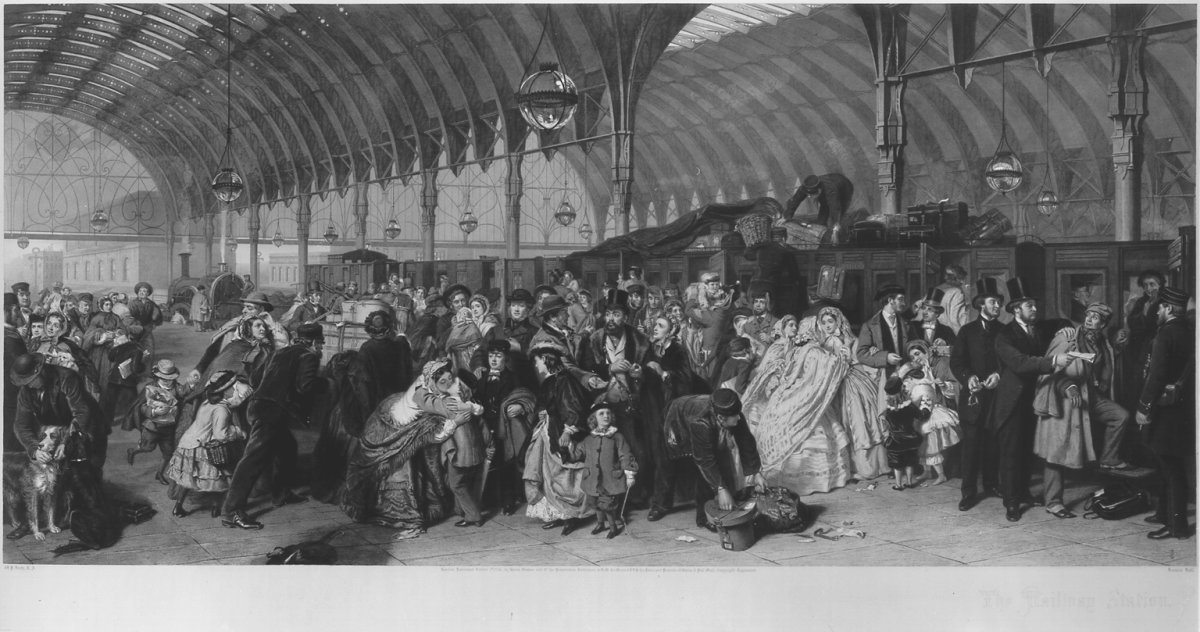The Railway Station
William Powell Frith (1819 - 1909)
Francis Holl (1815 - 1884)
Engraving
published 1 October 1866
-
About the work
- Location
-
Country: USA
City: Washington DC
Place: British Embassy
This engraving was made after William Powell Frith’s painting ‘The Railway Station’, one of the best-known images of 19th-century Britain. Frith’s original work is now in the collection of Royal Holloway College, part of the University of London. It was first exhibited in 1862 at the gallery of dealer Louis Victor Flatow, on Haymarket, London. Flatow paid the outstanding sum of £5,250 for the painting and rights of exhibition and reproduction. The work was shown for seven weeks, during which time it attracted more than 21,000 visitors.
‘Somebody has said that life is made up of meetings and partings…’ playright Tom Taylor wrote in the catalogue published to coincide with the exhibition; ‘Mr Frith has chosen as the scene of his picture one of the places in which life, thus conceived, is best epitomised - the platform of a railway station.’ Taylor spoke of the ‘poetry’ of Turner’s and Wordsworth’s responses to the railway and compared their approach with Frith’s ‘prose’, which demonstrates ‘its infinite varieties, its heights and depths of tragedy, comedy and farce.’
Prints after the picture, engraved by Francis Holl, made the image widely available.
-
About the artist
William Powell Frith was born near Ripon in Yorkshire. He studied at the Royal Academy Schools and was elected an Academician in 1852. During the 1840s he was a member of the artists' group 'The Clique'. Although his early subjects were historical or literary, Frith claimed to have been ‘strongly drawn’ to contemporary genre. He first painted the subject following a visit to Ramsgate of 1851, which resulted in ‘Ramsgate Sands’ (exhibited 1854). He went on to paint ‘Derby Day’ (1858), ‘The Railway Station’ (1862) and ‘Private View Day at the Royal Academy’ (1883). His 19 children - twelve with his wife and seven with his mistress - caused considerable financial difficulties. Frith died of pneumonia aged 90, at his home in St John's Wood.
Francis Holl was born in Camden Town, London, and became a successful and prolific engraver, sometimes collaborating with his engraver brother William. For 25 years he was engraver to Queen Victoria, receiving numerous private commissions from her for portraits of the royal family. He also engraved plates after works by contemporary artists, including Frith’s ‘The Railway Station’ (1862). He exhibited 20 engravings at the Royal Academy (1856-83) and was elected an associate in 1883. He was an amateur actor and a member of the Histrionics, who played at St James's Theatre. In 1841 he married Alicia, with whom he had four children. The family lived in Gloucester Road, Regent's Park, until 1879 when Holl retired to Surrey. He died aged 68.
-
Explore
- Places
- Subjects
- railway station, steam train, railway, train, cricket bat, topography, genre, dog, boy, baby, man, woman, girl, crowd, 19th century costume, dress, frock coat, military uniform, waistcoat, trousers, top hat, walking stick, bonnet, suitcase, shoe, porter, basket, kissing, jar, handcuffs
- Materials & Techniques
- engraving
-
Details
- Title
- The Railway Station
- Date
- published 1 October 1866
- Medium
- Engraving
- Dimensions
- height: 61.00 cm, width: 117.00 cm
- Acquisition
- Purchased from Christopher Wood Gallery, February 1982
- Provenance
- Sold through Bonhams, London, on 18 December 1981 (Lot 35); from which sale purchased by Christopher Wood Gallery, London; from whom purchased by the Government Picture Collection in February 1982
- GAC number
- 16043